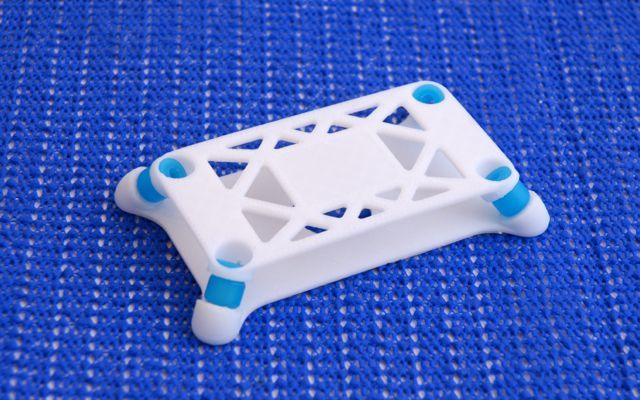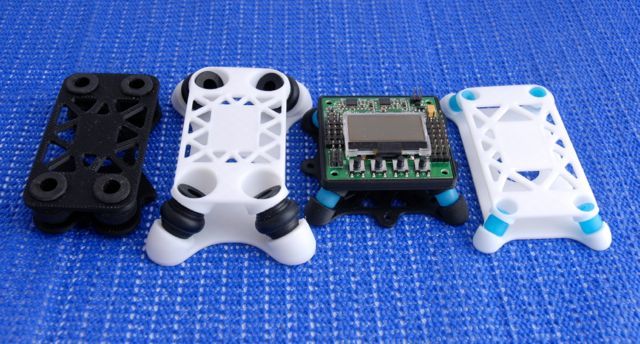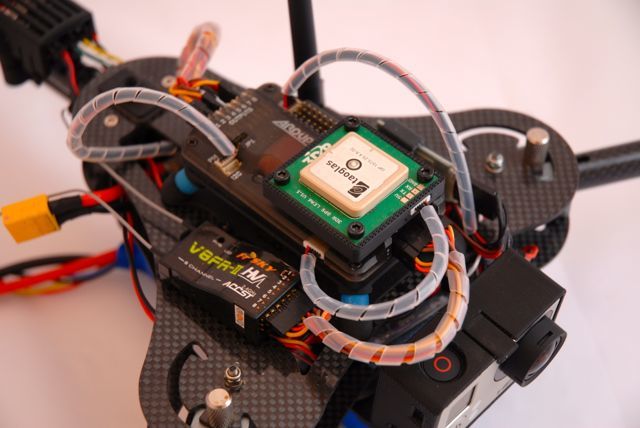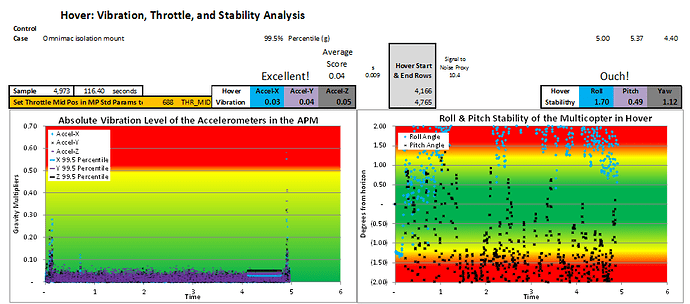The following was a blog posted to DIY Drones in 2013. I’ve moved it here to ensure it remains part of the Ardupilot community, should DIYdrones be discontinued in light of 3DR’s recent push towards commercial markets.
Update for 2016: This hardware is not necessary for flight controllers with internal dampening, such as the Pixhawk 2. It was a solution to Z-axis vibration issues that could result in uncontrolled behaviour while APM was still using DCM for sensor integration. It was designed to be cheap and robust using readily available off the shelf parts, and not necessarily as an optimum solution to vibration issues. Extensive testing has not been performed with the updated EKF used in modern Ardupilot versions, so it’s possible that it’s unnecessary for Pixhawk 1 based derivatives using the latest firmware. It is still useful for APM derivatives using DCM filtering, or for airframes with significant vibration issues.

Over the last few weeks, I’ve been prototyping different anti vibration mount designs using an Up Mini 3D printer. I wanted something that performed well, using affordable and readily available components.

The first design started with anti vibration dampeners in a simple vertical configuration. This suffered from too much play in the horizontal plane, which might have caused instability in quick accelerations. The next design rotated the dampeners 45°, which resulted in much more even resistance across the horizontal and vertical planes.
The large rubber dampeners provide outstanding isolation. Too much in fact. The ideal anti vibration mount isolates the controller from high frequency vibrations, but conducts lower frequency vibrations that might represent small changes in attitude. For the next design, I moved to smaller and slightly stiffer dampeners available from Hobby King.

I’ve been testing them on a Turnigy Talon tricopter, using an APM 2.5. The GPS is mounted to the top of the APM to increase the moving weight, which assists slightly in reducing higher frequency vibrations.
The results so far suggest that it’s working very well:
The above graph is taken from a two minute hover in loiter mode. All axes are below ±0.1, which exceeds the specifications set out in Arducopter guidelines.
Using a tool that Forrest Frantz developed, we can see these results from another perspective:
The Acceleration results are still excellent, but the pitch and roll stability shows a bit of oscillation. I’m using default PID values which would definitely benefit from tuning, and flying in slightly windy conditions. I’m also new to rotary wing flight, so I’m still honing my flying skills. I’m able to keep the tricopter in a 1m x 1m x 1m cube, but it slowly drifts around if there is a change in wind.
These are the most likely causes, but in the interests of full disclosure, I wanted to mention that it could be caused by the APM not responding to small changes in attitude if the mount is creating too much isolation. It certainly doesn’t appear to be affecting flying performance, the tricopter is impressively stable in loiter mode. I won’t know if it’s an issue or not until more people try Forrest’s tool out, so I have more data to compare my results to.
STL and original 3dm (Rhino 3d) files can be found on Thingiverse for the following flight controllers:
APM (Side Entry)
Pixhawk
PX4
KK2
OP/Naze/MultiWii/36mm flight controllers
These were previously released under a CC-SA-NC licence, but have been re-released under a GNU - GPL licence. Depending on when or where you downloaded the files, you are free to choose the licence that suits you best. I will also be migrating away from Thingiverse once I have found a suitable alternative, and will update this post accordingly.
To complete the mount, you’ll need to purchase dampeners from a supplier, or make your own using intensewalkera’s 3d printable mould (link). Hobby King appears to be one of the most convinient global suppliers:
Original (stiffer) blue dampeners
New (softer) dampeners
Update, 30th of April 2014
Earlier this year, Bob Moore approached me and asked if he could become a distributer for the Omnimac series of mounts. I’m pleased to announce his site is now live, and can be viewed at:

Purchasing through Bob will get you a complete mount (including dampeners) at a cheaper price than Shapeways, that has been printed using FDM technology. Any queries regarding Bob’s products should be directed to his contact page, which can be found here: Contact Us
Bob had previously been supporting me with a small amount of the proceeds of each sale. This had made a significant difference to my financial situation, particularly as I was going through some tough times in 2014 and 2015. As of this post, and re-releasing the files under the GPL licence, I’ve asked for this arrangement to stop, but still strongly encourage people without access to 3D printers to use Bob’s services.

